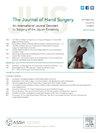Changes in Management at the Postoperative Visit After In-Office Wide Awake Local Anesthetic No Tourniquet Carpal Tunnel Release
IF 2.1
2区 医学
Q2 ORTHOPEDICS
引用次数: 0
Abstract
Purpose
Patients are commonly seen for two postoperative visits following carpal tunnel release (CTR), the first visit being at 1–2 weeks and the second at approximately 6 weeks. Our study aimed to determine if these visits led to changes in postoperative medical management.
Methods
A retrospective review was conducted of 748 procedures performed in an in-office procedure room under wide awake local anesthetic no tourniquet between August 2020 and December 2022. Charts were reviewed for changes in management related to the patient’s CTR. Management changes involving a separate diagnosis or solely an additional follow-up visit were classified as unrelated to postoperative CTR care.
Results
A total of 730 patients returned for follow-up. There were 100 patients (13.7 %) who had a CTR-related change in management at the first postoperative visit. Most management changes at this timepoint were due to superficial surgical site infection. There were 29 patients (4.0 %) who had a CTR-related change in management at their second postoperative visit, most commonly a referral to therapy for stiffness or hypersensitivity.
Conclusions
While postoperative visits for CTR may have intangible benefits, changes in CTR-related care occur only in 17.7% of patients.
Type of study/level of evidence
Therapeutic IV.
全醒局麻无止血带腕管松解术后随访管理的变化。
目的:患者通常在腕管释放(CTR)术后两次就诊,第一次是在1-2周,第二次是在大约6周。我们的研究旨在确定这些就诊是否会导致术后医疗管理的改变。方法:回顾性分析2020年8月至2022年12月间,在全清醒局麻、无止血带的情况下在办公室手术室进行的748例手术。回顾了与患者CTR相关的管理变化的图表。涉及单独诊断或仅额外随访的管理变化被归类为与术后CTR护理无关。结果:730例患者回访。有100例患者(13.7%)在术后第一次就诊时发生了与cr相关的管理改变。这个时间点的大多数治疗改变是由于浅表手术部位感染。29例患者(4.0%)在术后第二次就诊时发生了与治疗相关的改变,最常见的是转诊治疗僵硬或过敏。结论:虽然CTR术后就诊可能有无形的好处,但只有17.7%的患者改变了与CTR相关的护理。研究类型/证据水平:治疗性IV。
本文章由计算机程序翻译,如有差异,请以英文原文为准。
求助全文
约1分钟内获得全文
求助全文
来源期刊
CiteScore
3.20
自引率
10.50%
发文量
402
审稿时长
12 weeks
期刊介绍:
The Journal of Hand Surgery publishes original, peer-reviewed articles related to the pathophysiology, diagnosis, and treatment of diseases and conditions of the upper extremity; these include both clinical and basic science studies, along with case reports. Special features include Review Articles (including Current Concepts and The Hand Surgery Landscape), Reviews of Books and Media, and Letters to the Editor.

 求助内容:
求助内容: 应助结果提醒方式:
应助结果提醒方式:


